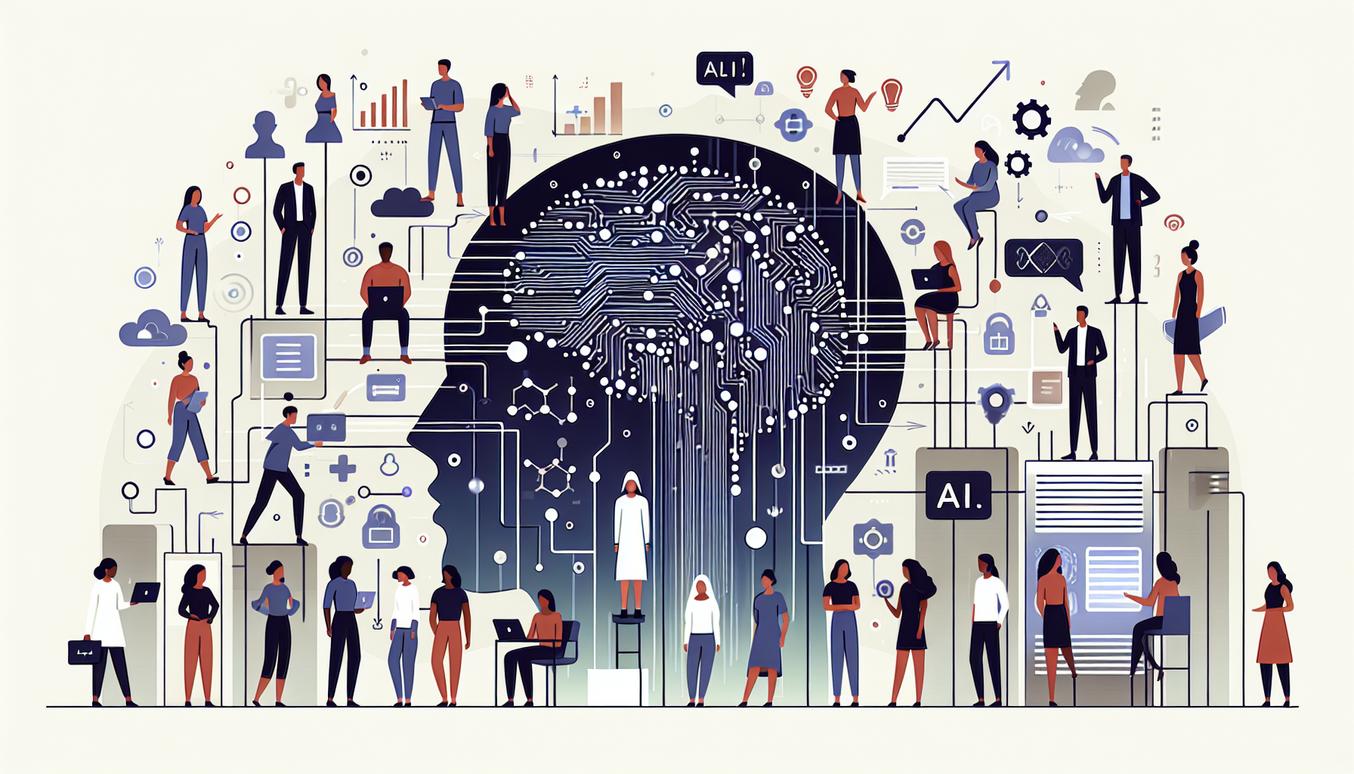Table of Contents
- Introduction: Purpose and Scope
- What Generative AI Is and Why It Matters
- Foundational Concepts: Neural Networks and Learning Paradigms
- Architectures in Practice: Transformers, Diffusion Models, and Beyond
- Training Realities: Datasets, Compute, and Cost Considerations
- Measuring Model Quality: Metrics, Bias Detection, and Robustness
- Application Snapshots: Healthcare, Finance, Automation, and Analytics
- Responsible AI Practice: Governance, Privacy, and Accountability
- Deployment Blueprint: Infrastructure, Scaling, and Monitoring
- Operational Checklist: Compliance, Logging, and Lifecycle Management
- Case Vignette: Hypothetical Deployment from Prototype to Production
- Future Trends: Multimodality, Efficiency, and Regulatory Signals
- Further Reading and Vetted Resources
- Executive Summary and Actionable Takeaways
Introduction: Purpose and Scope
This whitepaper serves as a comprehensive guide for technology leaders, data scientists, and policymakers navigating the complex landscape of Generative AI. Its purpose is to demystify the core technologies, outline the practical realities of deployment, and provide a robust framework for responsible governance. We bridge the gap between deep technical concepts and strategic operational planning, offering a non-vendor-specific blueprint for harnessing the power of Generative AI while mitigating its inherent risks. This document focuses on foundational knowledge, practical application, and forward-looking strategy, providing actionable insights for building and managing these transformative systems.
What Generative AI Is and Why It Matters
At its core, Generative AI refers to a class of artificial intelligence models capable of creating new, original content—such as text, images, audio, and synthetic data—that is statistically similar to the data it was trained on. Unlike traditional discriminative AI, which classifies or predicts from existing data (e.g., identifying spam in an email), Generative AI synthesizes novel outputs. This fundamental difference marks a paradigm shift from pattern recognition to pattern creation.
Its importance cannot be overstated. Generative AI is a catalyst for innovation, enabling hyper-personalized user experiences, accelerating scientific discovery, and automating complex creative and analytical tasks. For organizations, it represents a powerful tool to unlock new efficiencies, create novel products, and gain a significant competitive advantage. However, its capabilities also introduce new challenges in ethics, security, and governance that demand careful consideration.
Foundational Concepts: Neural Networks and Learning Paradigms
The engine behind modern Generative AI is the artificial Neural Network, a computational model inspired by the structure of the human brain. These networks consist of interconnected layers of nodes, or “neurons,” that process information. The complexity and depth of these layers (hence “deep learning”) allow them to learn intricate patterns from vast amounts of data.
These models are trained using several learning paradigms:
- Supervised Learning: The model learns from a dataset where each input is paired with a correct output (a label). This is akin to learning with an answer key and is foundational for many classification and regression tasks.
- Unsupervised Learning: The model is given data without explicit labels and must find patterns and structures on its own. This is crucial for tasks like clustering and is a key component in training many large-scale Generative AI systems.
- Reinforcement Learning: The model learns by interacting with an environment, receiving rewards or penalties for its actions. Reinforcement Learning with Human Feedback (RLHF) is a critical technique used to align Generative AI models with human preferences and instructions.
Architectures in Practice: Transformers, Diffusion Models, and Beyond
While neural networks provide the foundation, specific architectures have enabled the recent explosion in Generative AI capabilities. Two of the most prominent are Transformers and Diffusion Models.
The Transformer architecture, introduced in 2017, revolutionized natural language processing. Its key innovation is the self-attention mechanism, which allows the model to weigh the importance of different words in an input sequence. This ability to understand context makes Transformers exceptionally powerful for tasks like language translation, summarization, and text generation, forming the basis for Large Language Models (LLMs) like GPT and PaLM.
Diffusion Models have become the state-of-the-art for high-fidelity image generation. They work through a two-step process: a “forward” process that systematically adds noise to an image until it becomes unrecognizable, and a “reverse” process where a trained neural network learns to gradually remove that noise, starting from a random seed to generate a new, coherent image.
Training Realities: Datasets, Compute, and Cost Considerations
Developing a foundational Generative AI model from scratch is a monumental undertaking defined by three key resources: datasets, compute, and capital.
- Datasets: These models require colossal amounts of training data—often terabytes or petabytes scraped from the public internet, licensed archives, and proprietary sources. The quality, diversity, and cleanliness of this data are paramount, as they directly influence the model’s capabilities, biases, and knowledge base.
- Compute: Training involves immense computational power, typically requiring thousands of specialized processors like GPUs (Graphics Processing Units) or TPUs (Tensor Processing Units) running in parallel for weeks or months. This demand has made access to high-performance computing a critical bottleneck.
- Cost: The combination of data acquisition, compute resources, and expert personnel results in training costs that can run into the tens or hundreds of millions of dollars. Consequently, most organizations will leverage pre-trained models and adapt them through fine-tuning, a far more cost-effective approach.
Measuring Model Quality: Metrics, Bias Detection, and Robustness
Evaluating the quality of a Generative AI model is a multifaceted process that goes beyond simple accuracy. A rigorous model evaluation framework is essential before deployment.
Performance Metrics: Standardized benchmarks are used to score models on specific tasks. For text, metrics like BLEU or ROUGE measure similarity to reference text. For images, FID (Fréchet Inception Distance) assesses the quality and diversity of generated images. However, these metrics often fail to capture nuance, creativity, or factual correctness.
Bias and Fairness: Models trained on internet data can inherit and amplify societal biases related to gender, race, and culture. Bias detection involves probing the model with targeted prompts and using statistical tests to uncover skewed or harmful associations. Auditing for fairness is a critical step in responsible AI development.
Robustness: This refers to the model’s ability to maintain performance under adverse conditions. Testing includes evaluating its resilience to adversarial attacks, where subtle, malicious changes to input can cause the model to fail spectacularly, and checking for “hallucinations”—the tendency to generate confident but factually incorrect information.
Application Snapshots: Healthcare, Finance, Automation, and Analytics
The practical applications of Generative AI are already transforming industries:
- Healthcare: Accelerating drug discovery by generating novel molecular structures and predicting protein folding. Synthetic patient data generation helps train other ML models without compromising real patient privacy.
- Finance: Creating synthetic transaction data to improve fraud detection algorithms. Developing sophisticated chatbots for personalized wealth management advice and customer service.
- Automation: Automating code generation and debugging for software developers. Generating draft reports, marketing copy, and internal documentation, freeing up employees for higher-value tasks.
- Analytics: Serving as a natural language interface to complex databases, allowing non-technical users to query data and generate insights. Generating plausible hypotheses from data for further investigation.
Responsible AI Practice: Governance, Privacy, and Accountability
Deploying Generative AI responsibly is a non-negotiable prerequisite for long-term success and public trust. A strong Responsible AI framework must be established, focusing on governance, privacy, and accountability.
Governance involves creating clear internal policies, review boards, and documentation standards. It means defining acceptable use cases, establishing protocols for bias testing, and ensuring human oversight is maintained in critical applications. A central AI governance committee can ensure that principles are translated into consistent practice across the organization.
Privacy is a primary concern, as models can inadvertently memorize and regurgitate sensitive information from their training data, including personally identifiable information (PII). Mitigation strategies include rigorous data anonymization, differential privacy techniques, and careful filtering of model outputs.
Accountability addresses the question of who is responsible when a model produces harmful, biased, or incorrect content. This requires establishing clear lines of ownership for AI systems, maintaining detailed logs for auditability, and creating transparent mechanisms for users to report issues and seek recourse.
Security and Misuse Mitigation
Generative AI introduces unique security vulnerabilities that require proactive mitigation. Prompt injection, where attackers hijack a model’s output by crafting malicious instructions, is a primary threat. Another is data poisoning, where adversarial data is secretly introduced into the training set to corrupt the model. Organizations must implement input sanitization, output monitoring, and access controls to defend against these and other threats, like model theft or the generation of malicious content like phishing emails or disinformation.
Deployment Blueprint: Infrastructure, Scaling, and Monitoring
Moving a Generative AI model from a research environment to a production system requires a robust deployment blueprint.
Infrastructure decisions revolve around whether to use cloud-based services or on-premise hardware. Cloud providers offer managed infrastructure and scalable access to powerful GPUs, simplifying deployment. An on-premise solution offers greater control and potential cost savings at scale but requires significant capital investment and expertise.
Scaling for production use means optimizing for inference—the process of generating outputs from the model. Techniques like quantization (reducing model precision) and model distillation (training a smaller model to mimic a larger one) can reduce latency and computational cost, enabling the system to handle thousands of concurrent requests.
Monitoring is a continuous process. Key areas to track include model performance (accuracy, latency), resource utilization (GPU, memory), and output quality. Detecting “model drift”—where performance degrades over time as real-world data changes—is crucial for knowing when to retrain or update the model.
Integration Approaches: APIs, Embeddings, and Pipeline Patterns
Integrating Generative AI into existing products and workflows can be achieved through several patterns. The simplest is through APIs from foundation model providers, which allow for rapid prototyping and deployment with minimal infrastructure overhead. A more advanced approach involves using a pre-trained open-source model and fine-tuning it on proprietary data for a specific task. For information retrieval, embeddings—numerical representations of text—can be used to build powerful semantic search and retrieval-augmented generation (RAG) systems that ground the model’s responses in specific, verified documents.
Operational Checklist: Compliance, Logging, and Lifecycle Management
Effective operational management ensures that a deployed Generative AI system remains reliable, compliant, and secure over its entire lifecycle.
- Compliance: Regularly audit the system against relevant regulations, such as the EU AI Act or data privacy laws like GDPR. Maintain comprehensive documentation of the model’s design, training data, and testing results.
- Logging and Auditing: Log all inputs (prompts) and outputs generated by the model. This is essential for debugging, monitoring for misuse, and providing an audit trail for accountability. Implement a system for users to provide feedback on output quality.
- Lifecycle Management: Implement MLOps (Machine Learning Operations) best practices. This includes version control for models, data, and code; automated retraining and deployment pipelines; and a clear policy for retiring models that are outdated or no longer performant.
Case Vignette: Hypothetical Deployment from Prototype to Production
A financial services firm, “FinInnovate,” decided to build a Generative AI tool to summarize earnings call transcripts for its analysts. The project progressed in stages:
- Prototype: The data science team used a pre-trained open-source LLM and a RAG framework to build a proof-of-concept. They demonstrated the ability to quickly answer questions and generate summaries based on a small set of transcripts.
- Fine-Tuning and Evaluation: After securing executive buy-in, the team fine-tuned the model on a proprietary dataset of thousands of annotated transcripts to specialize its understanding of financial jargon. They rigorously tested it for factual accuracy and bias.
- Staged Rollout: The tool was first deployed to a small group of senior analysts. Their feedback was used to refine the user interface and the model’s performance. Extensive logging and monitoring were implemented.
- Full Production: After a successful pilot, the tool was rolled out to the entire analytics department, integrated into their existing workflow with robust security controls and a clear governance policy. The MLOps team established a quarterly retraining schedule to keep the model updated.
Future Trends: Multimodality, Efficiency, and Regulatory Signals
Looking toward 2025 and beyond, several key trends will shape the future of Generative AI.
- Multimodality: Models will become natively multimodal, seamlessly processing and generating content across text, images, audio, and video. This will enable more intuitive and powerful human-computer interfaces.
- Efficiency and Specialization: The trend toward ever-larger models will be counterbalanced by a push for efficiency. Smaller, specialized models (SLMs) optimized for specific tasks will become more common, reducing computational costs and enabling deployment on edge devices.
- Regulatory Signals: Governments worldwide are moving to regulate AI. Frameworks like the EU AI Act, expected to see enforcement starting in 2025, will establish new requirements for transparency, risk management, and data governance for high-risk AI systems, setting a precedent for global standards.
Further Reading and Vetted Resources
For those seeking to deepen their technical understanding, the following resources provide foundational knowledge on key concepts:
- Artificial Neural Networks: An overview of the core component of deep learning. https://en.wikipedia.org/wiki/Artificial_neural_network
- Transformer Models: Details on the architecture behind most modern LLMs. https://en.wikipedia.org/wiki/Transformer_(machine_learning_model)
- Diffusion Models: A technical explanation of the state-of-the-art in image generation. https://en.wikipedia.org/wiki/Diffusion_model_(machine_learning)
- Reinforcement Learning: An introduction to the learning paradigm used for model alignment. https://en.wikipedia.org/wiki/Reinforcement_learning
- AI Ethics (Responsible AI): A broad look at the ethical challenges posed by AI systems. https://en.wikipedia.org/wiki/AI_ethics
- Model Evaluation: A guide to the process of assessing model performance. https://en.wikipedia.org/wiki/Model_evaluation
Executive Summary and Actionable Takeaways
Generative AI represents a profound technological shift, offering immense potential for innovation and efficiency. However, realizing this potential requires more than just technical implementation. It demands a holistic strategy that integrates cutting-edge technology with rigorous governance, operational discipline, and a steadfast commitment to responsible practice. The journey from a promising prototype to a valuable, production-grade AI system is complex and fraught with challenges related to cost, security, and ethics.
Actionable Takeaways for Leaders:
- Prioritize Governance from Day One: Establish a cross-functional AI governance body to set policies, review high-risk use cases, and ensure ethical principles are embedded in the development lifecycle. Do not treat governance as an afterthought.
- Invest in People and Process, Not Just Technology: The success of Generative AI depends on skilled teams and robust MLOps practices. Focus on building internal expertise and implementing scalable, repeatable processes for model management.
- Adopt a Portfolio Approach: Not all problems require a massive, custom-trained model. Balance the use of third-party APIs for speed, fine-tuning open-source models for customization, and building from scratch only for truly unique, high-value applications.
- Plan for a Dynamic Regulatory Environment: Stay informed about emerging AI regulations. Build systems with transparency, auditability, and data privacy at their core to ensure future compliance and maintain user trust.









